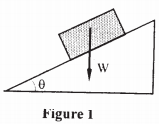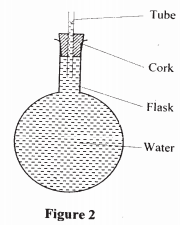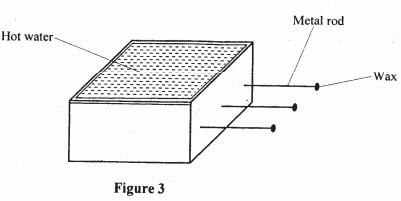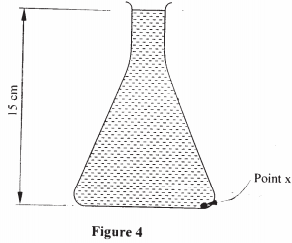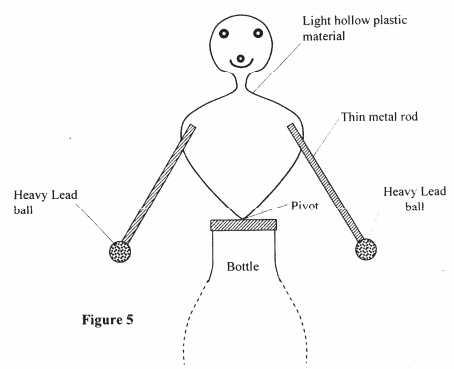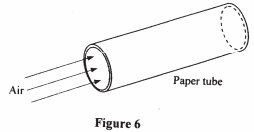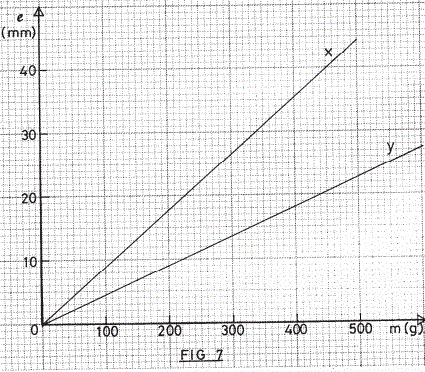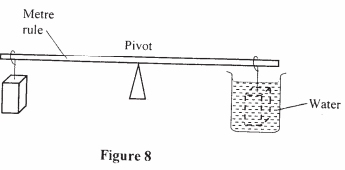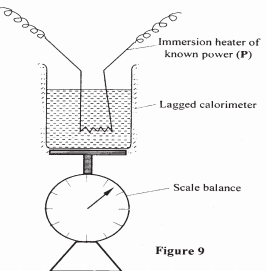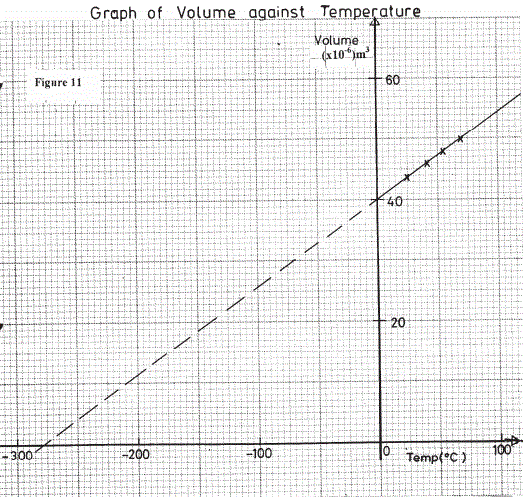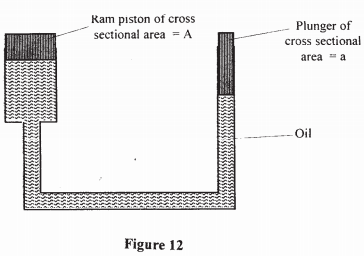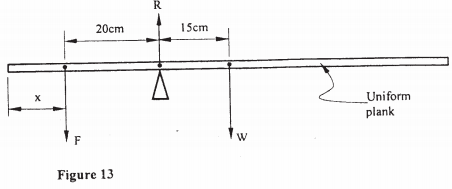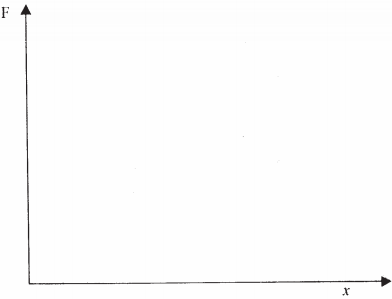SECTION A (25 marks)
Answer all the questions in this section in the spaces provided.
- A drug manufacturer gives a mass of the active ingredient in a tablet as 5 mg.
Express this quantity in kilogramme and its standard form. (1 mark) - The masses of equal volumes of a certain liquid and of water were found to be ml and mw respectively. Given that the density of the water is 1 gcm-3, express the density, ρ, of the liquid in terms of ml and mw. (Show your work) (2 marks)
- Figure 1 shows a brick placed on a plane inclined at an angle θ to the horizontal. The weight, W of the brick is as shown.
- On the same diagram, show with arrows the other two forces acting on the brick and name them. (1 mark)
- State how each of the two forces named in (a) above is affected hen the angle θ is reduced. (1 mark)
- Water is known to boil at 100oC. A student heat some water and noticed that it boiled at 101oC.
State two possible reasons for the observation. (2 marks) - Figure 2 shows a flask filled with water. The flask is fitted with a cork through which a tube is inserted. When the flask is cooled, the water level rises slightly, then falls steadily.
Explain this observation. (3 marks)Figure 3 shows a hot water bath with metal rods inserted through one of its sides. some wax is filled at the end of each rod. Use this information to answer question 6 and 7.
- What property of metals could be tested using this set-up? (1 mark)
- Besides the length of the rod that is kept constant, what else should be kept constant when comparing the property for the different metal rods? (1 mark)
- Figure 4 shows a conical flask 15cm high, filled with a liquid of density 1200kgm-3. The atmospheric pressure of the surrounding is 8.4×104Pa.
Determine the pressure at the point marked X, at the bottom of the flask. (3 marks) - Explain the difference between a liquid and a gas in terms of intermolecular distances and forces. (5 marks)
Figure 5 shows a toy resting on top of a closed bottle. Use the information on the figure to answer question 10 and 11.
- Mark on the diagram point Q, the approximate centre of gravity of the toy. (1 mark)
- Giving a reason, name the state of equilibrium of the toy. (2 marks)
- Figure 6 shows a sheet of paper rolled into a tube.
When a fast stream of air is blown into the tube as shown in the diagram, the paper collapses. Explain the observation. (2 marks) - The graphs in figure 7 represent the relations between extension e and mass m added to to strings x and y.
Given that the two strings are made of same material, give a reason why the graphs are different. (1 mark) - The system in figure 8 is an equilibrium.
When the temperature of the water is raised the system is observed to tilt to the right, state the reason for this observation. (2 marks)SECTION B (55 marks)
Answer all the questions in this section in the spaces provided.
- State Newton's second law of motion. (1 mark)
- A matatu starts from rest and accelerates to cover a distance of 49m in 7 seconds.
Determine:- its acceleration (3 marks)
- its velocity after 7 seconds. (2 marks)
- its acceleration (3 marks)
- A trolley moving on a horizontal bench of height 1.2m, strikes a barrier at the edge of the bench. The brass on top of the trolley flies off on impact and lands on the ground 2.5m from the edge of the bench.
Determine:- the time taken by the brass mass to reach the ground; ( 2 marks)
- the speed at which the lorry struck the barrier. (2 marks)
- State Newton's second law of motion. (1 mark)
- Define the term heat capacity. (1 mark)
- You are provided with the apparatus shown in figure 9 and a stop watch.
Describe an experiment to determine the specific latent heat of steam, l, using the set up. In your answer clearly explain the measurements to be made and how these measurements could be used to determine l (6 marks) - A block of metal of mass 150g at 100oC is dropped into a lagged calorimeter of heat capacity 40JK-1 containing 100g of water at 25oC. The temperature of the resulting mixture is 34oC. (Specific heat capacity of water = 4200JKgK-1).
Determine:- heat gained by calorimeter. (2 marks)
- heat gained by water. (1 mark)
- heat lost by the metal block. (1 mark)
- specific heat capacity of the metal block. (3 marks)
- What is meant by absolute zero temperature? (1 mark)
Figure 10 shows a set up used to investigate the relationship between temperature and volume for a certain gas.
- State two factors that are kept constant, in order to determine the relationship. (2 marks)
- The graph in figure 11 shows the relationship between volume and temperature for the experiment.
- What was the volume of the gas at 0oC? (1 mark)
- At what temperature would the volume of the gas be zero? (1 mark)
- Explain why the temperature in part (ii) above cannot be achieved. (2 marks)
- What was the volume of the gas at 0oC? (1 mark)
- A sealed gas cylinder contains 300cm3 of acertain gas at a temperature of 25oC, and at pressure of 9.5×104Pa. The gas in the cylinder was then cooled to 10oC.
Determine the new pressure of the gas in the cylinder. (4 marks)
- What is meant by absolute zero temperature? (1 mark)
- Define the term velocity ratio of a machine. (1 mark)
- Figure 12 shows a part of a hydraulic press. The plunger is the position where effort is applied while the Ram piston is the position where the load is applied. The plunger has cross-section area, a m2 while the Ram piston has cross-section area, A m2.
When the plunger moves down a distance d the Ram piston moves up a distance D.- State the property of liquid pressure on which the working of the hydraulic press works. (1 mark)
- Derive an impression for the velocity ratio (V.R) in terms of A and a. (4 marks)
- A machine of velocity ratio 45, overcomes a load of 4.5×105N when an effort of 135N is applied.
Determine:- the mechanical advantage of the machine; (2 marks)
- effeciency of the machine; (2 marks)
- the percentage of the work that goes to waste. (1 mark)
- Define the term velocity ratio of a machine. (1 mark)
- State the principal of moments. (1 mark)
- A uniform metal strip is 3.0cm wide, 0.6 cm thick, d 100cm long. The density of the metal is 2.7g/cm3.
- determine the weight lof the strip. (3 marks)
The strip is placed on a pivot and kept in equilibrium by forces as shown in figure 13.
- Determine the value of F and R. (3 marks)
F ...........................................................
R ........................................................... - x is the distance from the end of the plank to the point of application of force F. Force F is now applied at various points nearer to the pivot so that x increases. Equilibrium is maintained all the time. On the axes provided, sketch the relation between force F and x. (1 mark)
- Give a reason for your answer in (iii) above. (1 mark)
- determine the weight lof the strip. (3 marks)
Download Kenya Certificate of Secondary Education (KCSE 2008) Physics Paper 1.
Tap Here to Download for 50/-
Get on WhatsApp for 50/-
Why download?
- ✔ To read offline at any time.
- ✔ To Print at your convenience
- ✔ Share Easily with Friends / Students

